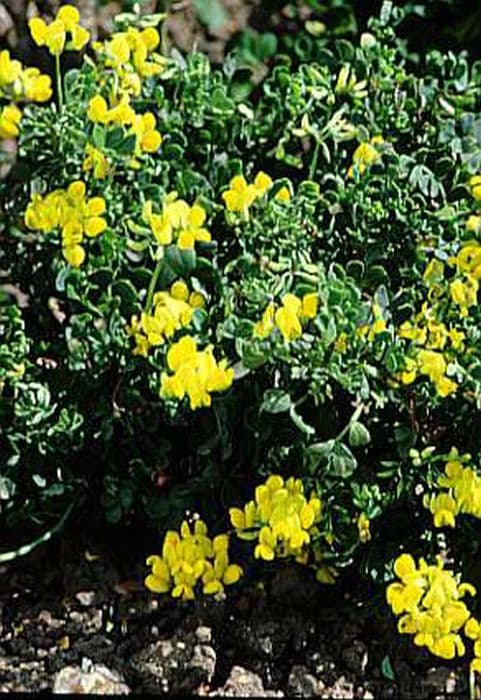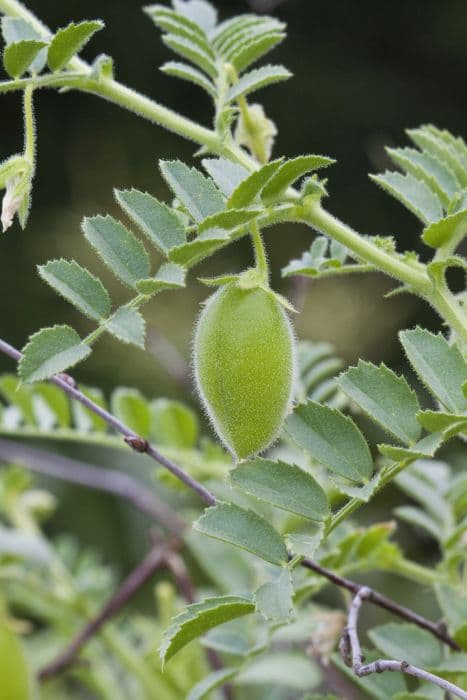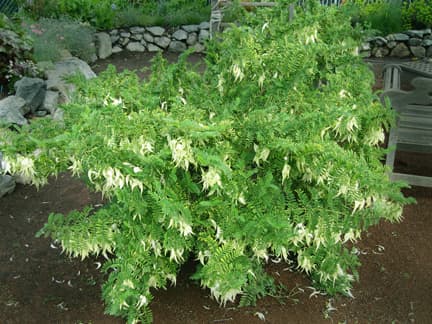Lupine Lupinus 'Terracotta'

ABOUT
The Lupinus 'Terracotta', commonly known as the Lupine or Lupin, is a flowering herbaceous plant known for its ornate and vibrant flower spikes. Its appearance is quite striking due to the unique coloration of its blossoms, which evoke the warm, earthy tones of terracotta clay—hues of burnt orange, amber, and rust, sometimes blending into a soft yellow or cream at the edges of the petals. These flowers are densely packed on tall spires that rise elegantly above the foliage, creating a prominent and picturesque display in any garden setting. The foliage of the Terracotta Lupine adds to its beauty, with palmate leaves that have a radiating form resembling the fingers of a hand. Each leaflet is narrow and pointed, with a fine, almost velvety texture and a deep green color that contrasts beautifully with the warm tones of the blooms. The blossoms of the Terracotta Lupine are not only visually appealing but also attract a variety of pollinators, including bees and butterflies, which adds to the allure and vitality of the plant. The plant's overall grace and its propensity to bloom in late spring to early summer make it a popular choice for gardeners who wish to add a splash of warm color to their landscape.
About this plant
 Names
NamesFamily
Fabaceae
Synonyms
Lupine, Terracotta Lupine
Common names
Lupinus 'Terracotta'.
 Toxicity
ToxicityTo humans
The Lupinus 'Terracotta', commonly referred to as lupine, is toxic to humans if ingested. All parts of the lupine plant, including the seeds, contain alkaloids that can be poisonous. Symptoms of lupine poisoning might include nausea, vomiting, abdominal pain, dizziness, agitation, confusion, and in severe cases, heart and nervous system problems may occur.
To pets
Lupines are toxic to pets as well. If your pet ingests any part of a Lupinus 'Terracotta' or lupine, they may exhibit symptoms such as lethargy, lack of appetite, vomiting, diarrhea, rapid breathing, weakness, and incoordination. In severe cases, ingestion can lead to convulsions and even coma. Immediate veterinary attention is advised if poisoning is suspected.
 Characteristics
CharacteristicsLife cycle
Perennials
Foliage type
Deciduous
Color of leaves
Green
Flower color
Orange
Height
3 feet (91 cm)
Spread
2 feet (60 cm)
Plant type
Herb
Hardiness zones
5
Native area
North America
Benefits
 General Benefits
General Benefits- Attracts pollinators: The Lupinus 'Terracotta', commonly known as the Terracotta Lupine, produces flowers that attract bees, butterflies, and other beneficial insects, supporting local ecosystems.
- Nitrogen-fixing: Like other lupines, it adds nitrogen to the soil through symbiotic relationships with soil bacteria, improving soil fertility.
- Aesthetic appeal: With its distinctive terracotta-colored flowers, it adds unique and striking visual interest to gardens and landscapes.
- Erosion control: The Terracotta Lupine has a deep root system that can help stabilize soil and prevent erosion on slopes and banks.
- Drought tolerance: Once established, it is relatively drought-resistant, making it suitable for xeriscaping and low-water gardens.
- Wildlife habitat: It can serve as a food source and habitat for various wildlife species, contributing to biodiversity.
 Medical Properties
Medical PropertiesThis plant is not used for medical purposes.
 Air-purifying Qualities
Air-purifying QualitiesThis plant is not specifically known for air purifying qualities.
 Other Uses
Other Uses- Lupins as a natural dye: The flowers of the 'Terracotta' lupin can be used to create natural dyes for fabrics, producing soft, earthy tones reflective of their bloom color.
- Photographic subjects: The striking flowers of this lupin make it an excellent subject for botanical photography and garden portfolios.
- Educational tools: 'Terracotta' lupins, like other lupins, can be used to teach plant biology and hybridization techniques given their distinct characteristics and ease of cross-breeding.
- Green manure: Lupins can be used as green manure; when plowed back into the soil, they enrich it with nitrogen, which is beneficial for future crops.
- Artistic inspiration: The color and form of the 'Terracotta' lupin have inspired artists in various mediums, from watercolor to textile design.
- Garden design: 'Terracotta' lupins are used to add depth and contrast in garden design due to their warm terracotta hues, complementing both cool and warm color palettes.
- Biofuel research: Lupins are being explored as potential sources of biofuel, and the 'Terracotta' variety may contribute to research in terms of biomass production.
- Companion planting: 'Terracotta' lupins can be a valuable companion plant in vegetable gardens, aiding in pest control and improving surrounding soil quality.
- Soil stabilization: With their deep root systems, lupins like 'Terracotta' can help prevent soil erosion in vulnerable areas.
- Wildlife attraction: The blooms of 'Terracotta' lupins are known to attract beneficial insects, including bees and butterflies, which are vital for pollination in the garden ecosystem.
Interesting Facts
 Feng Shui
Feng ShuiLupine is not used in Feng Shui practice.
 Zodiac Sign Compitability
Zodiac Sign CompitabilityLupine is not used in astrology practice.
 Plant Symbolism
Plant Symbolism- Imagination: Lupines, including the 'Terracotta' variety, often symbolize imagination due to their rich, vivid colors and unique flower spikes that seem to reach upwards towards the sky.
- Innovation: The boldness of lupine blooms, like those of Lupinus 'Terracotta', can represent innovative thinking and creativity, perhaps because of their distinctive appearance among garden plants.
- Transformation: Lupines are also associated with transformation, as they can change barren landscapes into beautiful scenes, much like the transformative nature of the 'Terracotta' lupine's terra-cotta-colored blooms.
- Opportunity: The growth of lupines in challenging conditions suggests opportunity and the overcoming of obstacles, with the 'Terracotta' lupine exemplifying beauty and success in adverse environments.
- Resilience: The hardiness of Lupinus 'Terracotta' and its ability to thrive in less-than-ideal soil conditions make it a symbol of resilience and adaptability.
 Water
WaterTerracotta Lupine requires regular watering to maintain moist soil, especially during dry spells, typically amounting to once a week for established plants. Water the plants deeply with about 1 gallon per plant, ensuring water penetrates the root zone. Adjust the frequency to account for rainfall and check that the soil is dry an inch below the surface before watering again. In hotter climates or during particularly hot periods, the watering frequency should be increased to prevent stress from drought. Avoid overhead watering to prevent foliage diseases and instead water at the base of the plants.
 Light
LightTerracotta Lupine thrives best in full sunlight to partial shade, with a preference for a minimum of six hours of sunlight per day. The ideal spot for these plants would be an area where they receive morning sunlight and some afternoon shade, especially in regions with intensely hot summers. Ensure they are planted in a location where they receive ample bright light to support robust growth and blooming.
 Temperature
TemperatureTerracotta Lupines perform optimally in a temperature range of 60°F to 75°F. They can withstand minimum temperatures down to 20°F, but they may need protection from frost. Maximum temperatures above 85°F can stress the plants, so providing some shade during the peak heat of summer is beneficial. Ideal temperature conditions will encourage healthier growth and bloom production.
 Pruning
PruningPruning Terracotta Lupines promotes a tidy growth habit, removes spent flowers to encourage reblooming, and helps prevent disease. It's best to prune in the late winter or early spring, removing any dead or damaged stems. After blooming, deadhead old flower spikes to stimulate new blooms. If the plant becomes too dense, thin out some stems to improve air circulation.
 Cleaning
CleaningAs needed
 Soil
SoilLupine 'Terracotta' thrives best in a well-drained soil mix, rich in organic matter with a slightly acidic to neutral pH between 6.0 and 7.0. A blend of garden soil, compost, and sand or perlite ensures proper drainage and fertility.
 Repotting
RepottingLupines, such as 'Terracotta', typically do not require frequent repotting and can often be left undisturbed for several years. Repot when the plant outgrows its current container, usually every 2-3 years.
 Humidity & Misting
Humidity & Misting'Terracotta' Lupine prefers moderate humidity and does well in typical outdoor environments, without needing specific humidity adjustments.
 Suitable locations
Suitable locationsIndoor
Bright light, cool temps, well-drained soil, low humidity.
Outdoor
Full sun, well-drained soil, space plants 18" apart.
Hardiness zone
4-8 USDA
 Life cycle
Life cycleLupine 'Terracotta', commonly known as Terracotta Lupine, begins its life cycle when seeds are sown in well-draining soil, often in early spring or after the danger of frost has passed. The seeds germinate, and seedlings emerge, developing into young plants with distinctive palmate leaves. As the plant matures, it enters the vegetative stage, where it focuses on leaf and stem growth, storing energy for flowering. Following vegetative growth, the Terracotta Lupine enters the flowering stage, typically in late spring to early summer, producing tall, colorful spikes of terracotta-orange flowers that attract pollinators. After pollination, the flowers develop into seed pods that mature and eventually open to release seeds, completing the reproductive cycle. If conditions are not favorable for seed germination, the seeds can enter a period of dormancy until conditions improve, ensuring the survival and continuation of the species.
 Propogation
PropogationPropogation time
Spring to early summer
The most popular method of propagating the Lupine 'Terracotta' is by seed. The best time to sow Lupine seeds is in late winter to early spring, ensuring they have a full growing season to establish themselves. To propagate by seed, first, soak the seeds in water for a period of 24 hours to soften the hard outer shell and promote germination. Next, sow the seeds in a well-draining soil mix, placing them at a depth of approximately 1/8 inch (3 mm). Ensure to space the seeds at a distance that allows for ample growth, typically a few inches apart. Keep the soil consistently moist but not waterlogged, and place the seeds in a warm, bright area without direct sunlight. Germination can take anywhere from two to six weeks. Once seedlings develop true leaves, they can be transplanted if necessary.




![Kowhai [Sun King]](/_next/image?url=https%3A%2F%2Fplants-admin.emdemapps.com%2Fimages%2Fplants%2F%2Fimages%2F604b57cb7f598.png&w=640&q=75)




